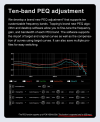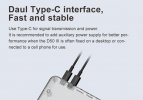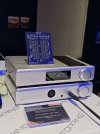thanks and that's disappointing
-
WANTED: Happy members who like to discuss audio and other topics related to our interest. Desire to learn and share knowledge of science required. There are many reviews of audio hardware and expert members to help answer your questions. Click here to have your audio equipment measured for free!
- Forums
- Audio, Audio, Audio!
- DACs, Streamers, Servers, Players, Audio Interface
- Digital To Analog (DAC) Reviews and Discussion
You are using an out of date browser. It may not display this or other websites correctly.
You should upgrade or use an alternative browser.
You should upgrade or use an alternative browser.
Topping D50 III Balanced DAC with EQ Review
- Thread starter amirm
- Start date
Bleib
Major Contributor
- Joined
- May 13, 2021
- Messages
- 1,696
- Likes
- 3,041
Well, this is obviously their first shot at it, we can all expect more of it later on (and not just the far more expensive D90 III discrete)thanks and that's disappointing
But not at this price.we can all expect more of it later on (and not just the far more expensive D90 III discrete)
You need a proper DSP or CPU to do that on all inputs, I suppose.
somebodyelse
Major Contributor
- Joined
- Dec 5, 2018
- Messages
- 4,198
- Likes
- 3,536
XMOS can receive spdif as seen in their example code, eval boards etc. It seems to be a Topping design decision.But not at this price.
You need a proper DSP or CPU to do that on all inputs, I suppose.
fabriceo
Member
- Joined
- Oct 9, 2020
- Messages
- 18
- Likes
- 69
Hi,XMOS can receive spdif as seen in their example code, eval boards etc. It seems to be a Topping design decision.
you are right that XMOS provide libraries to handle spdif input.
But nobody use them because the XMOS USB demo application is not made to route the SPDIF RX flow to the I2S DAC output... only to USB Host.
And then if you want to do it, you enter in tons of problems because again in this demo application (which everyone use) there is no possibility to free-run the I2S task and the USB task. this is just a night mare to implement. So usually the manufacturer just put an AKM ow WM receiver and they add a hardware multiplexer so that the SPDIF-I2S flow goes to the DAC instead of the XMOS. Or they even use directly the DAC SPDIF inputs (like on the Sabre)
I have implemented all these changes for another DAC manufacturer and even managed to enable multiple spdif rx task in parallel and this was a massive effort, but worth it
This is the only reason why they are not and will not be able to propose the PEQ equalizer for SPDIF input.
The next generation DACs with 10-band PEQ that works for all inputs, were already shown by Topping at the CanJam NYC.
The D90 III Discrete is based on a new discrete 1-bit DAC module using a positive and negative 16-element DAC for each channel.
Another more advanced DAC is the D900 which also comes with a 10-Band PEQ, but adds a much nicer display with a spectrum analyzer and other VU styles.
The D900 is based on the same DSM module but using a positive and negative 32-element DAC for each channel.
Both DACs will be probably shown at the Highend show in Munich.
Are these DACs the new RME ADI-2 DAC killer?
They look badass in person and the expected price will be WAY less than 2K. They expect final prices in Europe to be in the ballpark 1399€ (DAC) and 1299€ (headamp) but these are not numbers they can committ as of now. May be more, may be less.
As for being RME ADI-2 DAC killers, I would say a bit NO. Together they are way more expensive than a single RME and do not even offer the same feature set.
Last edited:
Surely they don't make their own DACs at Topping. So those would be the current models from AKM or ESS since there is noone else left in the high end of the market.
No, they DO make their own DACs. They do not manufacture the DAC CHIPS.
This one dates back to 2020.
At the time it was scoring as the best SINAD DAC measured by Amir.

Mola Mola Tambaqui DAC and Streamer Review
This is a review and detailed measurements of the Mola Mola Tambaqui USB DAC and Ethernet streamer. It is on kind loan from a member which is quite special when you consider it costing US $11,500 (£8,999). As it should be the Tambaqui weights a lot relative to its size with generous use of...www.audiosciencereview.com
And Bruno is designing a new DAC!
Benesyed
Active Member
- Joined
- Jan 15, 2023
- Messages
- 113
- Likes
- 94
They're fairly nicely made already. It's an aluminum housing, feels much more solid than pictures would make you think.
I have a topping and it's just ok from a design and materials perspective. Does it's job well!
Users of Topping D50 III, this Dac uses the USB type power and the product page says " It is recommended to add auxiliary power supply for better performance "
What does that auxiliary power supply mean ? Can we use LPS ? How does that improve the performance ?
Enlighten the novice
What does that auxiliary power supply mean ? Can we use LPS ? How does that improve the performance ?
Enlighten the novice
Attachments
Last edited:
There is a separate USB connector for power. If it is connected, the bus power of the data connector is not used, as the DAC negotiates as self-powered. Especially mobile devices have issues supplying significant amounts of bus power, so a separate power connector improves compatibility. Any USB power supply works, well-known brands are recommended. I don't know if phones come bundled with chargers anymore, but these are usually well-built.Users of Topping D50 III, this Dac uses the USB type power and the product page says " It is recommended to add auxiliary power supply for better performance "
What does that auxiliary power supply mean ? Can we use LPS ? How does that improve the performance ?
Thanks for your response @AtanasiThere is a separate USB connector for power. If it is connected, the bus power of the data connector is not used, as the DAC negotiates as self-powered. Especially mobile devices have issues supplying significant amounts of bus power, so a separate power connector improves compatibility. Any USB power supply works, well-known brands are recommended. I don't know if phones come bundled with chargers anymore, but these are usually well-built.
Alex_Brouwer
Member
- Joined
- Oct 24, 2023
- Messages
- 14
- Likes
- 16
Received mine yesterday, I must say after a nearly 15 year old ifi zen dac v2. This is one hech of a upgrade.
herr.jemine
Active Member
- Joined
- May 19, 2024
- Messages
- 147
- Likes
- 105
EQ can be saved and selected as a preset on the device, but the EQ is only audible in USB modethanks and that's disappointing
Last edited:
staticV3
Master Contributor
- Joined
- Aug 29, 2019
- Messages
- 9,743
- Likes
- 15,685
According to Topping, EQ is only applied to USB audio:EQ can be saved and selected as a preset on the device, so it also works with BT or other sources, only editing and creating a PEQ is done via the PC in USB mode !

Source
herr.jemine
Active Member
- Joined
- May 19, 2024
- Messages
- 147
- Likes
- 105
yes the display of the device is deceptive, the settings are also visible in BT mode, but they actually do not work - unfortunately it is true - I have had the device since today - I thought at first it would work
staticV3
Master Contributor
- Joined
- Aug 29, 2019
- Messages
- 9,743
- Likes
- 15,685
Sokel
Master Contributor
- Joined
- Sep 8, 2021
- Messages
- 7,014
- Likes
- 7,215
Yep,they can't.So, once the eq curves have been set and stored with USB, cannot be applied to other inputs than USB?
Similar threads
- Replies
- 181
- Views
- 53K
- Replies
- 460
- Views
- 138K
- Replies
- 13
- Views
- 2K
- Replies
- 31
- Views
- 4K


